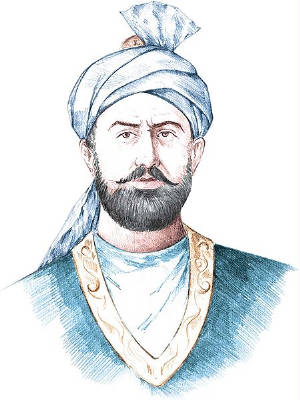THe Hotakis
The
Hotaki were a Pashtun (Afghan) tribe and
dynasty that ruled the Persian Empire from 1722 to 1729, after defeating and
replacing the Safavid dynasty. The dynasty was founded in 1709 by Mir Wais
Hotak, the tribal chief of the Ghilzai Pashtuns of Kandahar.
Mirwais and his followers rose against the Safavid
dynasty of Persia in Kandahar City in April of 1709, killing George XI (Gurgīn
Khān), the Georgian governor of Kandahar province and the direct
representative of the Persian kings. Next, Mirwais ordered the deaths of the
remaining Persian government officials in the region. The Afghans then defeated
twice a large Persian army that was dispatched from Isfahan (capital of the
Safavid Empire).

|
| Amir - Mir Wais Khan Hotaki |
Several half-hearted attempts to subdue the rebellious city
having failed, the Persian Government despatched Khusraw Khán, nephew of the
late Gurgín Khán, with an army of 30,000 men to effect its subjugation, but in
spite of an initial success, which led the Afgháns to offer to surrender on
terms, his uncompromising attitude impelled them to make a fresh desperate
effort, resulting in the complete defeat of the Persian army (of whom only some
700 escaped) and the death of their general. Two years later, in A.D. 1713, another
Persian army commanded by Rustam Khán was also defeated by the rebels, who thus
secured possession of the whole province of Qandahár.
Mirwais died peacefully in 1715 from natural cause and was succeeded by his
brother Abdul Aziz, who was quickly killed by Mir Wais' son Mahmud. Mir Mahmud
Hotaki had Bipolar Disorder. Mir Mahmud Hotaki would eventually succumb to his
bipolar disorder or manic depression after a tumultous short-lived reign. (see
historical comments about his decline in mental health and insanity.)In 1722,
Mahmud led an Afghan army and invaded Persia. After defeating the Persian army
at the Battle of Gulnabad on March 8, 1722, he proceeded to and sacked the city
of Isfahan. On October 23, 1722, Soltan Hossein abdicated and acknowledged
Mahmud as the new shah of Persia.
Majority of the Persian people, however, rejected the Afghan regime as
usurping. For the next seven years until 1729, the Hotakis became the de facto
rulers of Persia, but the southern and eastern areas of Afghanistan remained
under their control until 1738.
 The Hotaki
dynasty was a troubled and violent one as internecine conflict made it
difficult to establish permanent control. The dynasty lived under great turmoil
due to bloody succession feuds that made their hold on power tenuous, and after
the massacre of thousands of civilians in Isfahan – including more than three
thousand religious scholars, nobles, and members of the Safavid family – the
Hotaki dynasty was eventually removed from power in Persia.
Ashraf Khan,
who took over the monarchy following Shah Mahmud's death in 1725, and his
soldiers were defeated in the October 1729 Battle of Damghan by Nader Shah,
head of the Afsharid Turkmens. Nadir Shah had driven out the remaining Ghilzai
forces from Persia and began enlisting the Abdali Afghans of Herat in his military.
Nadir Shah's forces (among them were Ahmad Shah Abdali and his 4,000 Abdali
troops) conquered Kandahar in 1738. They destroyed the last Hotaki seat of
power, which was held by Hussien Hotaki (or Shah Hussien). Nader Shah then
built the new town "Nāderābād", named after himself, next to
the old destroyed Ghilzai's town.
|
 |
|
|
 |
|
|
 |
|
|
|

